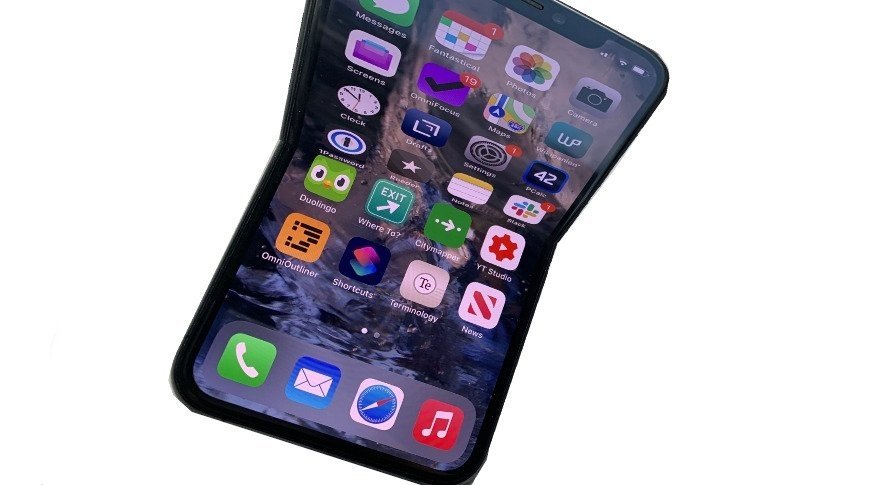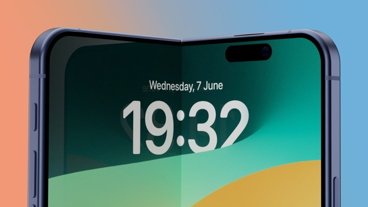Apple is predicted to launch a foldable iPhone with 8-inch flexible OLED display sometime in 2023, with the company planning for shipments of as many as 20 million units that year, according to analyst Ming-Chi Kuo.
In a research note to investors, Kuo forecasts Apple's first foldable iPhone to boast an 8-inch QHD+ display, which at 3,200-by-1,800 pixels is a higher effective resolution panel than Samsung Fold's 7.3-inch QXGA+ screen. QHD+ displays also feature a perfect 16:9 aspect ratio, a deviation from the current 19.5:9 ratio seen on both iPhone 12 and iPhone 12 Pro.
Whether the upcoming iPhone will fold horizontally or vertically was left unmentioned in Monday's report.
"Our latest survey indicates that the fast-growing foldable smartphone market has become a must-have for all major smartphone brands," Kuo writes. "The foldable smartphone will boost the next super replacement cycle for high-end models."
Apple is expected to manufacture between 15 million and 20 million foldable iPhone units in 2023. When the handset will see launch is unknown, though the relatively low production estimate suggests a debut alongside traditional iPhone formats in the fall.
Samsung Display is anticipated to act as Apple's exclusive display supplier, while Samsung Foundry will handle display driver ICs, Kuo said. Previous rumors pointed to a partnership with LG Display, with reports as recently as February claiming Apple tapped the company to assist in the development of foldable screen technology. At the time, it was unclear if LG would ultimately supply hardware for a production version of the foldable.
While Samsung will supply panels and driving circuitry for the future iPhone, it is not expected to manage the handset's touch solution, according to Kuo. Instead of Samsung's Y-Octa technology, Apple is predicted to use TPK's silver nanowire touch solution. TPK tech is durable and capable of supporting multiple folds and rollable displays and medium to large screen sizes, Kuo notes.
HomePod's touch panel utilizes a silver nanowire touch solution, though it is unclear if TPK is the supplier.
Looking ahead, Kuo believes permutations of foldable designs could permeate through Apple's product line.
"At present, the product position of foldable smartphones is mainly to integrate the smartphone and tablet. But we believe that the foldable smartphone is only one of the applications of the foldable design," Kuo said. "We predict that foldable devices will blur the product segmentations between smartphones, tablets, and laptops in the future. With its cross-product ecosystems and hardware design advantages, Apple will be the biggest winner in the new foldable device trend."
After years of sporadic rumors, Apple's ambitions in the foldable smartphone segment are slowly becoming clear as market competitors like Samsung release second-generation versions of their own designs. Kuo in March said Apple might launch a 7.5- to 8-inch foldable in 2023 if it can hammer out production issues related to the advanced technology this year.
 Mikey Campbell
Mikey Campbell







-m.jpg)






 Marko Zivkovic
Marko Zivkovic
 Mike Wuerthele
Mike Wuerthele
 Christine McKee
Christine McKee
 Amber Neely
Amber Neely
 Sponsored Content
Sponsored Content
 Wesley Hilliard
Wesley Hilliard

 William Gallagher
William Gallagher








47 Comments
For Apple to offer a foldable phone, there still exists some real challenges:
Appropriate hardware technology would have to be available.
First, the display would need to be covered with a non-malleable and scratch-resistant surface; there’s little chance Apple would return to a malleable and markable, plastic display cover. The challenge is that the necessary display properties are, of course, incompatible with folding and are likely to remain so.
Next, the phone when folded will need to be as ready to hand, and pocket, as current iPhones, to which any foldable iPhone, in folded configuration, will be ruthlessly compared.
Next there’s the reliability aspect. iPhones, and high-end Android phones, are all very solidly constructed these days, with few or no moving parts. But that doesn’t imply even today’s phones are free of physical wear and tear or immune to extreme conditions. Extreme cold or heat will be significant issues to account for in selecting materials and designing folding phones to yield a similar lifespan compared to their non-folding counterparts. For iPhones that implies a five- or six-year lifespan. Not to mention tensile stresses of the folding process itself.
The only viable solution my limited brain can conceive is two separate displays, each pressed up hard against a lip on a hinge to prevent dust or cookie crumbs intruding. As the phone unfolds, at the last part of the arc, that lip recedes, allowing the two screen edges to come together perfectly, leaving not a single pixel width gap between. How incredibly precise would such a mechanism need to be... boggles the mind. But if it worked, every time, for five or six years, it would allow two glass-covered displays to perfectly come together as one, without a visible seam.
The thought occurs to me that this is where the so called "obsession with thinness" finally pays off.
So far, the folded phones seem a bit thick for pocketing, but if each half is even thinner than the thinnest iPhone, then the folded thickness would be less of a concern. (Then again, even the thinnest wallets that can still hold cash and a good number of cards aren't exactly slim, so I guess it's all relative).
The larger concern I have is regarding the lifespan of the fold/seam, but if that can be properly addressed, then it would be a good time to consider a foldable phone.
If you no longer need a case that might be a draw to some. I like wallet cases and don’t think this will work.
You know what needs bigger screen and has way less screen damage..? Laptops.
It seems Apple will need to either catch up or give up. Foldable phones are coming. Or, maybe they are here already. Regardless, in either case, they are not going away.
Huawei Mate X2: Mastering the folding phone formula
"Huawei has revealed the third iteration of its folding smartphone, abandoning its previous designs and taking some inspiration from Samsung.
This time, the folding display on the Mate X2 is protected inside the phone.
BBC Click's Chris Fox went hands-on with the phone and described it as the best folding phone so far - but it still lacks Google services, which lets it down for UK consumers."
https://www.bbc.com/news/av/technology-56945791
-------------------------------------------------------------------------------------------------------------------
The lines between the different product categories in the world of computers are becoming increasingly grey:
-- Laptops long ago began to challenge desktops for speed and capacity. Now tablets are starting to challenge laptops in the same way.
-- The iPad is challenging the Mac as a laptop as a functional alternative (while 2 in 1's have already merged the two products into one)
-- Now smart phones are challenging the tablet world. This Huawei folding phone provides the same screen real estate as an iPad mini -- in a form factor you can carry in your pocket.
Meanwhile, Apple continues to try to keep the old rigid lines between categories and has only yielded grudgingly to blurring the line between tablet and laptop. But, soon it will be facing pressure to blur the line between phone and tablet.
But, that can't last. Just as soft moving water wears away the hardest rock, moving technology wears away the hardest purity tests.
Perhaps the analogy is Steve Jobs insistence on keeping the iPhone small -- because he thought of his iPhone primarily as a phone rather than a computer. But the world of technology didn't wait. It moved on to large screened phones and Apple, with the iPhone 6, was forced to surrender and join the wave...